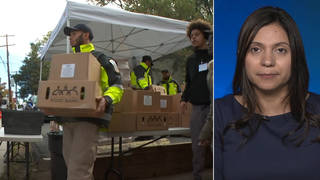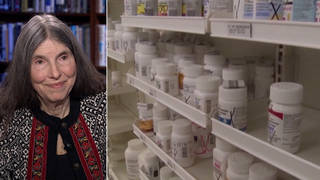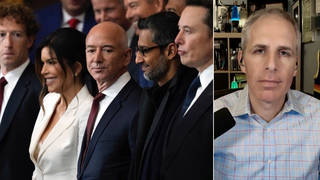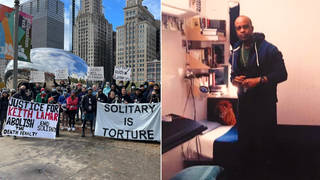
Topics
Guests
- Anthony Ray Hintonspent nearly 30 years on death row. He was released on Friday after evidence was presented of his innocence.
- Bryan Stevensonfounder and executive director of the Equal Justice Initiative. He is an attorney who has worked on death penalty cases in the Deep South for decades. He has represented Anthony Ray Hinton since 1999. He is the author of Just Mercy: A Story of Justice and Redemption.
Days after being exonerated and freed from an Alabama prison, Anthony Ray Hinton recounts how he got through nearly 30 years on death row as an innocent man. Hinton was convicted of murdering two fast-food managers in separate robberies in 1985, based on scant evidence that later turned out to be false. Hinton is said to be among the longest-serving death row prisoners ever to be freed after presenting evidence of innocence. Hinton joins us along with his attorney, Bryan Stevenson of the Equal Justice Initiative, who says race, poverty, inadequate legal assistance, and prosecutorial indifference to innocence conspired to create a textbook example of injustice. “This is a very powerful demonstration of the critique of the American criminal justice system, which we contend treats you better if you’re rich and guilty than if you’re poor and innocent,” Stevenson says.
Transcript
AMY GOODMAN: We begin today’s show in Alabama, where a prisoner, Anthony Ray Hinton, was released Friday after spending nearly 30 years on death row.
ANTHONY RAY HINTON: For all those that say that we believe in justice, this is the case to start showing, because I shouldn’t have sit on death row 30 years. All they had to do was test the gun. But when you think you’re high and mighty and you’re above the law, you don’t have to answer to nobody. But I’ve got news for you. Everybody that played a part in sending me to death row, you will answer to God. That’s all I have to say right now.
AMY GOODMAN: Anthony Ray Hinton was convicted of murdering two fast-food managers in separate robberies in 1985. He was 29 years old at the time. The only evidence linking Hinton to the crimes were bullets that allegedly had markings matching a revolver that belonged to Hinton’s mother. There were no fingerprints or eyewitness testimony. After Hinton was convicted, subsequent tests found the bullets at the scene could not be matched to the gun he was accused of using.
Last year, the U.S. Supreme Court threw out his conviction, concluding Hinton had been inadequately represented at trial. Hinton could not afford a defense lawyer. His court-appointed attorney used as a witness a firearms expert he knew to be incompetent. According to the Equal Justice Initiative, which won his release, Hinton is among the longest-serving death row prisoners ever to be freed after presenting evidence of innocence.
We go now to Montgomery, Alabama, where we’re joined by Anthony Ray Hinton himself, just freed, as well as Bryan Stevenson, founder and executive director of the Equal Justice Initiative, the attorney who has worked on death row penalty cases in the Deep South for decades and represented Anthony Ray Hinton since 1999. He is the author of the book, Just Mercy: A Story of Justice and Redemption. His book was just nominated for the Andrew Carnegie Medal for Excellence, run by the American Library Association.
We welcome you both to Democracy Now! Anthony Hinton, let’s begin with you. How does it feel to be free?
ANTHONY RAY HINTON: Well, it feels wonderful. A little scary at times, especially when I’ve been out to the mall, and I’m not used to being around that many people at one—at a certain setting.
AMY GOODMAN: Where were you, Anthony, in prison, when you heard that you would be freed? When was it?
ANTHONY RAY HINTON: I was out in the day room at the Birmingham Jefferson County Jail and just had got through talking to one of the attorneys from EJI, and he told me to call Mr. Stevenson right away. And I called Mr. Stevenson, and Mr. Stevenson gave me the news, the wonderful news.
AMY GOODMAN: Bryan Stevenson, why did you take on this case? How did you hear about Anthony Ray Hinton, in prison for, at the point you took it on—I mean, he was freed after 30 years. How did you hear about the case?
BRYAN STEVENSON: Well, we actually monitor almost all of the cases involving people sentenced to death here in Alabama. There is no public defender system. There is no right to counsel. We’ve got people on death row here who are literally dying for legal assistance. And so, we’re pretty familiar with all of the cases.
We had recruited some lawyers to represent Mr. Hinton, but it’s a very difficult thing to take on. If you don’t have a lot of resources and if you’re far away, it’s hard. So, we had known about the case for some time. Mr. Hinton and I had actually met many years earlier. When his lawyers could no longer represent him, we decided to take the case on, and I got personally involved. And I just have to say how extraordinary it is to be sitting next to my friend and my client. We’ve spent so many hours together at home in prison, but we’ve never been able to sit together in suits in a place like this. And I have to say it’s an extraordinary, extraordinary feeling.
AMY GOODMAN: So, Bryan, can you explain this case? You took it on in 1999. Go back to 1985 and what happened, what evidence wasn’t presented, what evidence was presented.
BRYAN STEVENSON: Well, in many ways, this is a very powerful demonstration of the critique of the American criminal justice system, which we contend treats you better if you’re rich and guilty than if you’re poor and innocent.
There was a great deal of concern in the community because these restaurant managers had been murdered. They had these bullets. They falsely claimed that these bullets could be linked to a single weapon. They then falsely claimed that that weapon was Mr. Hinton’s. Because his lawyer was only paid $1,600 to represent him, he couldn’t get an expert that was competent to disprove that. He got someone who was visually impaired, a civil engineer. And the jury convicted Mr. Hinton. You know, had he had the resources to get the kind of legal help he needed, he would have never been convicted.
The real problem was years later. When we developed the evidence that showed that these bullets could not be matched to a single gun and that it wasn’t Mr. Hinton’s gun, the state then refused, for 16 years, to even retest the evidence. And that, for me, was the most distressing part of this case. It was indifference. It was irresponsible. It was really unconscionable that they chose to risk executing an innocent person over risking the perception that they were somehow making a mistake or not being tough on crime. And they fought us tooth and nail.
And I have to say, it was quite an unlikely and rare occurrence that we could get the United States Supreme Court to intervene when we did. Had they not intervened, I think the risk of a wrongful execution would have been very, very high. There’s been no accountability. The experts have not been held accountable. The prosecutors have not been held accountable. There’s been no apology. There’s been no offer of any kind of assistance. And I think this case is a really shameful example of all the reforms that are desperately needed.
I might also say, Amy, that race was a factor here, too. I can’t leave that out. The investigators who worked on this case had been previously charged in federal court for torturing black prisoners. They had been using cattle prods to coerce statements out of black prisoners. The prosecutor claimed that Mr. Hinton was innocent. By looking at him, he said he could tell he was evil, just by looking at his face. That prosecutor had been reversed many times for excluding African Americans from serving on juries. And Mr. Hinton was convicted in part because of the burden of—the presumption of guilt that gets assigned to too many black and brown people in this country when they’re accused of a crime.
AMY GOODMAN: Now, Anthony Ray Hinton, you were on death row for nearly 30 years. Did you ever face an execution date?
ANTHONY RAY HINTON: No, I didn’t. Thank God, I didn’t ever face an execution date. I thought about it a lot of time. But like I stated before, I just had faith that God would not let me be executed for something that I didn’t do.
AMY GOODMAN: Before 1999—that was some well over a decade after you were imprisoned on death row, before EJI, the Equal Justice Initiative, Bryan Stevenson took your case on—did you ever think that your verdict would be overturned? Who could you appeal to?
ANTHONY RAY HINTON: Well, to be honest with you, when you is placed on death row, you have to have strong faith. And the lawyer that I had, that represented me during trial, once the case go through the Alabama criminal court of appeal and you lose there, you’re on your own. So, I had wrote Mr. Stevenson and asked for assistance from them. And he got me an attorney out of Boston. And to be perfectly honest with you, the lawyer that from Boston come down and talked to me, and he stayed on the case maybe a year or so, a couple years, and it just wasn’t working out in the way that I thought the case should be going. And I remember specifically that he told me he was trying to get me on life without. And I told him, “Get that for someone that is guilty. I’m innocent.” I need someone that would believe in me and would fight for my life as hard as they could, and that’s when Mr. Stevenson then came in.
AMY GOODMAN: And this issue of money—I mean, the ballistics expert, explain his limited vision, let alone his incompetence. And was money the key issue here, Anthony, being able to hire a competent ballistics expert?
ANTHONY RAY HINTON: Yes, money was very important. Not only the expert that I had at the time of my trial—he was blind in one eye. When he went to the forensic science to check the gun, he didn’t even know how to turn on the basic machine. He had to ask for help to turn on the machine. And that should have been a red flag for those men that’s sitting there watching him, watching this man ask for help. And not only that, he said once he got up under the microscope, all he could see was his finger. So, he testified in court that he had very limited eyesight. He had very limited in the telescope that he was using. I just don’t understand how a judge or anyone could qualify him as being an expert. And they kept using the term, “Well, he knows more than the average person.” I think there’s some laws need to be changed around here. Just because you read a magazine about surgery, don’t mean I can come up to New York and give you open heart surgery. And so, this is what we need to try to change in Alabama, people just getting up on the stand and testifying, considering themselves an expert.
AMY GOODMAN: How did you maintain the sense of humor you have, Anthony? I mean, you were well respected by both the guards on death row and also other prisoners.
ANTHONY RAY HINTON: Oh, yes. I think I was born with this sense of humor. And that’s something that 20, 30 years that they took from me, they couldn’t take my soul. They couldn’t take the fact that I love to make people laugh. I think you can find humor in anything. And I used that as a tool to make other people forget their problem. I think it was my biggest asset that I had, that—having a sense of humor. I recall some time just sitting up there, and a correction officer would come by, and I’d say, “Hey, I need to go home for an hour, and I promise you I’ll come right back,” or just different little stuff that I would say every day to try to get myself through it, and as well as my other inmates that were surrounding with me.
AMY GOODMAN: Bryan Stevenson, the state’s evidence of a match discredited by three highly qualified firearms examiners, including the former chief of the FBI’s Firearms and Toolmarks Unit, who testified in 2002 that the bullets from all three crimes could not be matched to a single gun at all, much less to Anthony’s mother’s gun—2002. When you talk about they just wouldn’t review it, aren’t there laws that say you have to review exonerating evidence? I mean, the Supreme Court unanimously overturned the verdict.
BRYAN STEVENSON: No, you’re absolutely right, Amy. But no, there aren’t those kinds of laws. We rely on the integrity of prosecutors and the integrity of law enforcement officials to do what’s required. And in this case, there was an absence of integrity. There was an absence of leadership. There was an absence of goodwill. And that’s the challenge that we face right now.
Mr. Hinton is the 152nd person to be exonerated after being sentenced to death. That means for every nine people who have been executed in this country, we have now identified one innocent person. And if we had integrity, we would stop executing people until we dealt with these problems of unreliability. But that’s what was missing in this case.
We went to every attorney general in the state of Alabama during four administrations. We repeatedly asked the prosecutor. And they just decided to see if they could get away with holding onto this conviction. And it really is shameful, because while Mr. Hinton is a remarkable human being who had just incredible resolve, he was on death row when 53 other people were executed. They took them just a few feet from where he was housed and put them in the electric chair and strapped them on gurneys. And they tried to kill him every day of his time on death row.
And I still think we’ve got great challenges. There are some parts of the country that have created conviction integrity units. We don’t have them in Alabama. And I’d love to see the Supreme Court actually create some requirements that would make it easier for us to insist on the kind of testing we were denied for 16 years.
AMY GOODMAN: You were the 152nd person to be exonerated from death row, Anthony Ray Hinton. When you came outside, your first reaction to standing outside on the other side of the bars?
ANTHONY RAY HINTON: Ooh! Thanking God all along, seeing so many cameras and families and friends. It was a long time, but I just felt so relieved at knowing that I was finally being free for something that I’ve been telling people, extremely people, that I didn’t do. And I just—it was a feeling like I never felt before. And I can’t really explain it to you, but hopefully you can understand it. But from where I’ve been for 30 years, just to be able to come out and knowing that I wasn’t going to have to be locked back up, it’s just an amazing feeling.
AMY GOODMAN: Your mother died in 2002, when you were in prison?
ANTHONY RAY HINTON: Yes. Yes.
AMY GOODMAN: Were you able to visit her grave when you left?
ANTHONY RAY HINTON: Yes, I went to her grave. That was—that was my rock. That was everything I had. And I would have loved to been able to say, “They finally got it right, Mama, and I’m home.” I know she would have been the happiest person. She probably would have cooked me all my favorites. And we would have just sit down and hugged. And I wouldn’t have probably—I know she wouldn’t have let me left, and I definitely wouldn’t have left her arms. When you come up, my mother had to be my father. My father lost his mind when I was very young. And my mother instilled in us to do the right thing at all times. And she was just an extremely ordinary woman. And I loved her more than life itself. And I just felt that I owed it to her to fight as hard as I could, because she didn’t raise no killer. And I thank God that he brought me through. And I’m pretty sure that she’s jumping around in heaven, saying, “Thank you, Jesus.”
AMY GOODMAN: Bryan Stevenson, what about compensation? Anthony Ray Hinton was on death row for 30 years before he was freed, an innocent man.
BRYAN STEVENSON: Well, there’s no amount of money that can totally compensate you for that. They took something from him that they don’t have the power to give back. But I think that they ought to want to initiate anything they can do to pay for some of the outrageous injustice that this case creates. But I think if there’s going to really be any kind of meaningful response to this, not only should he be compensated, but people should be held accountable. People should apologize. People should do some soul searching.
We should create some procedures that mandate that when there’s evidence that suggests a person has been wrongly convicted, that that evidence has to be reviewed. Mr. Hinton passed a polygraph test when he was first arrested. He was locked in a warehouse working when one of these crimes took place, and they simply ignored that. And we need to change those procedures. The Supreme Court has actually immunized prosecutors and law enforcement officers and judges, in the Thompson case that was decided a couple of years ago. I think that’s a wrongly decided decision that should be changed. We’ve got to incentivize greater commitment and responsibility in these kinds of cases.
And then, finally, I think there has to be the creation of the kind of integrity conviction units that are too infrequent in this country. We’re going to have to mandate some reforms here. I just don’t believe that we can rely on the goodwill of the people who have been elected, particularly when they’ve acted as irresponsibly as they’ve acted in Mr. Hinton’s case.
AMY GOODMAN: I mean, explain that. In one of the murders that took place of a fast-food manager, Anthony was 15 miles away working in a place that was locked up, so you couldn’t get out. And also this polygraph test.
BRYAN STEVENSON: Yeah, yes. So, yeah, there were three crimes, actually. They only charged him with the two murders, but there was a third crime where the surviving victim—there was a surviving victim. And that took place at a Quincy’s restaurant in Bessemer. Mr. Hinton—it took—the crime took place around 12:15 in the morning. Mr. Hinton was working at a Bruno’s warehouse, a supermarket warehouse. He clocked in at 11:57 p.m. He was seen by the security guard going in. His supervisor gave him his work instructions for the night, a guy named Tom Dahl, at 12:10. The supervisor saw him repeatedly over the next several hours. There was no way that he could have committed this crime. And they knew that. They absolutely knew that. But because they had this gun and this false testimony, they decided to persist. They gave him a polygraph. He passed the polygraph. They said that the car that was used in this crime was a big Oldsmobile, which—a big Buick that had been reclaimed. He didn’t own a car like that. He was driving a small—a Nissan. And they just ignored all of that. And that’s where this presumption of guilt that gets assigned to black and brown people became a barrier. If he had been presumed innocent, no reasonable jury would have convicted him.
AMY GOODMAN: You mentioned—
BRYAN STEVENSON: He was presumed guilty.
AMY GOODMAN: You mentioned a integrity conviction unit. What do you mean by this?
BRYAN STEVENSON: There are some offices that have basically made a commitment to begin looking at cases where there is evidence of innocence. We’ve got—you know, our prison population has gone from 300,000 in 1972 to 2.3 million people today. There’s never been a time in America when we have more innocent people in jails and prisons than we have right now. We’ve invested in prisons. We’ve invested in policing. We’ve invested in prosecutors. We’ve invested in judges. We have not invested in the defense function to protect people from wrongful convictions. They don’t have a right to counsel. They can’t get to court. So, only when you create these units can you really push the state to take seriously these claims. There’s a prosecutor in Dallas that has done this. There are some places across the country where, if you have compelling evidence that you’ve been wrongly convicted, they will initiate the investigation. That does not exist in Alabama. It doesn’t exist in most states. But it needs to, given the incredible evidence that we have that there are so many wrongly convicted and condemned people in our jails and prisons.
AMY GOODMAN: Anthony Ray Hinton, can you describe the cell you were held in for nearly 30 years?
ANTHONY RAY HINTON: Yes. It’s five by seven. You have a bed that is mounted to the wall. You have the toilet, and you’ve got mesh wire in front of the cell. You’ve got a little slot where they bring you your trays. The floors is concrete. You don’t have no ventilation for air. It was dark, but now they had put some lights—come through and fixed the lights. So, it’s just the smallest cell, the smallest room you can imagine, being on death row.
AMY GOODMAN: The way people were killed on your death row, how many in the time that you were on death row? And what were the methods used?
ANTHONY RAY HINTON: When I was there, first got there in ’87, the method was primarily the electric chair. And it was about 30 yards, I would say, from my cell. And the next morning, by using the electric chair, you could actually smell the flesh of the person that they had executed the night before. So, they probably executed maybe 20 or 25 in the electric chair in a few—with the gurney.
AMY GOODMAN: Bryan Stevenson, the Equal Justice Initiative published a major report that we talked to you about, “Lynching in America: Confronting the Legacy of Racial Terror.” Do you see a connection between lynching and death row?
BRYAN STEVENSON: I do. I think that we created—there’s a narrative of racial difference that emerged in this country, actually during the time of slavery. When Mr. Hinton and I got together this morning, we paused outside our office, where we have these signs that talk about the slave trade. And we dehumanized people of color. We demonized them. We said that they were different. We said that they were dangerous. We said that we could own them to civilize them. And that narrative of racial difference was never really confronted. The Emancipation Proclamation didn’t deal with it. The 13th Amendment didn’t deal with it. And then we had these decades of lynching, of terrorism, directed at African Americans, because that same presumption of dangerousness and guilt made people comfortable doing horrific things to people during the course of these lynchings.
When the federal government threatened to intervene again in the South, there was great pressure to move the lynchings indoor. And that was really the beginning of the modern death penalty—the short, unreliable, meaningless trials where people were presumed guilty and quickly sentenced to death. And that legacy of inadequate justice, that begins with the Scottsboro Boys and continues in the '40s and ’50s and ’60s and ’70s and was on display in the 1980s when Mr. Hinton was wrongfully convicted, has never really been challenged. And so, yes, I don't understand why the state of Alabama, who has killed so many people of color, wrongly—the bodies of thousands of black men and women are buried in the ground where we are sitting, as a result of racial injustice and bigotry and ignorance.
And yet, we persist. Our death penalty—84 percent of the people who have been executed by capital punishment in this state are black. We have a death penalty that’s racially biased in so many ways. The prosecutor who prosecuted Mr. Hinton had been reversed several times for intentionally excluding, in an illegal manner, African Americans from serving on juries, and yet he was allowed to keep prosecuting cases. We’ve got 65 percent of all murder victims in this state are black, but 80 percent of the people on death row are there for crimes involving victims who are white. The evidence of racial bias is so extreme and so overwhelming, and yet we do nothing.
And you can’t understand that without understanding lynching, without understanding slavery, without understanding segregation. And we won’t overcome these problems until we start talking about these issues differently. And I hope that Mr. Hinton’s case can really begin the kind of soul searching and honest dialogue that we need to have, not only about our biased criminal justice system, but about the way we tolerate inequality and unfair treatment of the poor and people of color.
AMY GOODMAN: Well, I want to thank you both for being with us. Bryan Stevenson of the Equal Justice Initiative, attorney who represented Anthony Ray Hinton since 1999, and Anthony Ray Hinton, thank you so much for being with us. And congratulations on your freedom.
ANTHONY RAY HINTON: Thank you for having me. Thank you.
AMY GOODMAN: When we come back, believe it or not, we’re going to speak about the case of another man on death row, yes, for 30 years. His name is Glenn Ford. He now lays dying of cancer, but as a free man. His prosecutor, the lead prosecutor in the 1984 case that led to Glenn Ford being sentenced to death, is now speaking out. We ask you to take a listen to what he says, as we go to Shreveport, Louisiana. Stay with us.












Media Options